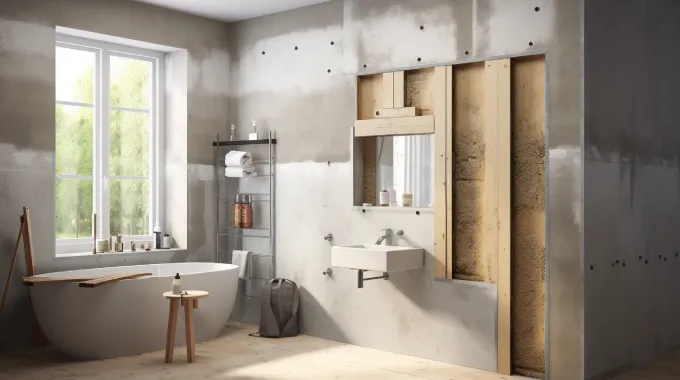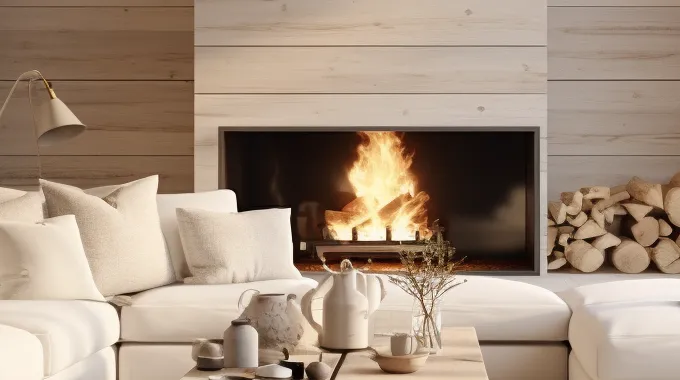Last Updated on September 16, 2023
As homeowners, you must make many decisions about your building materials, including whether or not to put a moisture barrier behind cement boards. While cement boards are water-resistant and won’t warp or break down, do you need a vapor retarder behind cement boards in wet places?
You will need a barrier underneath the cement board because they are porous. This means that without a barrier, moisture can seep through the cement board and potentially cause damage to the underlying structure of your walls.
A vapor barrier acts as a protective layer, preventing water vapor from passing through and reaching the wall cavity. It helps maintain a dry environment, reducing the risk of mold growth and structural issues.
Following this article, we will explore the necessity of a barrier below a cement board and why it is a smart investment for any construction project. So keep reading for more information.
Why Do You Need a Vapor Barrier Behind Cement Board?

If you’re wondering why a waterproofing membrane is necessary behind a cement board, there are a few things you should consider, such as:
- Enhanced moisture protection
- Mold and mildew prevention
- Insulation performance and energy efficiency
- Compliance with building codes
- Healthier indoor environment
Let’s discuss these reasons in more detail:
1. Enhanced Moisture Protection
To enhance moisture protection, consider using a vapor barrier behind the cement board. While the cement board is known for its moisture resistance, it is not a substitute for a barrier.
A waterproofing membrane provides an additional defense against moisture infiltration in wall cavities. Research has shown that even the most moisture-resistant materials allow some water vapor to pass through. This is where a barrier becomes crucial.
By installing a properly sealed moisture barrier behind the cement board, you can significantly reduce the risk of moisture-related issues, rotting wood, and insulation deterioration.
2. Mold and Mildew Prevention
Installing a properly sealed vapor barrier significantly reduces the risk of mold and mildew growth in wall cavities. When moisture accumulates behind cement boards, it creates an ideal environment for these harmful organisms to thrive.
Mold and mildew not only pose health risks but can also cause structural damage to your walls. Implementing a waterproofing membrane creates a protective shield that prevents water from getting into the wall cavity. This barrier acts as a barrier between the moist air and the interior walls, ensuring no condensation.
3. Insulation Performance and Energy Efficiency
Wet insulation loses its effectiveness and can lead to energy inefficiency. It increases energy consumption and decreases indoor comfort when water reduces insulation’s ability to resist heat flow.
Also, wet insulation creates a favorable environment for mold growth, which can further compromise the integrity of the insulation and affect indoor air quality.
To prevent moisture from reaching the insulation, it is essential to have a vapor barrier installed.
4. Compliance with Building Codes
Building codes are implemented to ensure structures meet specific safety and quality standards. In the case of wet areas like bathrooms, kitchen, many building codes mandate the installation of vapor barriers behind cement boards.
5. Healthier Indoor Environment
To maintain a healthier indoor environment, address moisture accumulation, and prevent the release of mold spores. Mold spores can exacerbate allergies and respiratory issues, posing a significant risk to your health.
Installing a vapor barrier behind the cement board is one effective way to mitigate mold growth. A barrier provides protection, preventing moisture from seeping into the walls and creating an ideal environment for fungi to grow.
Stopping moisture in its tracks can significantly reduce the chances of releasing mold spores into the air you breathe.
Considerations When Installing Vapor Barrier Behind Cement Board

When installing a moisture barrier behind the cement board, several important factors must be considered.
1. Specific Project Conditions
Assess your project conditions to determine whether a vapor barrier is needed behind the cement board. The humidity levels and moisture exposure in your area are crucial factors. High humidity can accumulate moisture, damaging the cement board and the surrounding materials.
Also, consider the local climate and its impact on moisture retention. If you live in a region with heavy rainfall or high levels of condensation, a barrier may be necessary to prevent water infiltration and potential mold growth.
2. Manufacturer Recommendations
When installing cement boards, consult the manufacturer’s instructions regarding using a vapor barrier. While some manufacturers may recommend using a barrier behind cement board, others may not consider it necessary.
The cement board is moisture-resistant and can act as a suitable barrier against moisture intrusion. However, adding a barrier behind the cement board may be beneficial in certain situations where excessive moisture is present or if your local building codes require it.
It is always best to follow the manufacturer’s recommendations and consult with professionals to ensure you take the appropriate measures for your project conditions.
3. Building Codes
To ensure compliance with local building codes, you must check if a vapor barrier is required for your project. Building codes vary from location to location, so it is important to adhere to the regulations related to moisture protection.
Consult local building authorities or code officials to determine the specific requirements for your project.
4. Installation Techniques
When installing a layer of insulation behind a cement board, it is crucial to follow proper installation techniques. Firstly, ensure the vapor barrier is installed over the framing before attaching the cement board. This will help create a continuous barrier that prevents moisture from seeping into the wall cavity.
It is also vital to seal all seams of the vapor barrier and cement board thoroughly. This can be done using an appropriate sealing tape or caulk specifically designed.
5. Waterproofing Membranes
Consider using specialized waterproofing membranes for added moisture protection. These membranes can enhance the longevity and durability of your tiled surfaces. They are specifically designed to create a barrier that prevents water from seeping through the surface and causing damage to the underlying materials.
These membranes act as a protective layer between the cement board and the tile. They ensure that no moisture penetrates the substrate. Applying a waterproofing membrane before tiling can effectively prevent issues such as mold growth, rotting, and deterioration of the structure.
These specialized membranes are made from high-quality materials that are resistant to water. They provide long-lasting protection. They are easy to install and perform better than traditional waterproofing methods.
Protect Your Installation and Prevent Mold Growth with Vapor Barrier Behind Cement Board

Installing a waterproofing barrier behind a cement board is a professional and necessary step in effectively managing moisture. The use of a barrier may seem confusing to those who are unfamiliar with construction techniques.
But remember that a barrier helps maintain the integrity of the installation for the long term by preventing moisture from penetrating through the cement board.
Ultimately, adding a barrier to your cement board installation is a conversational choice that will benefit the project’s longevity. We hope our article helped you understand why you should install a vapor barrier behind cement boards.



